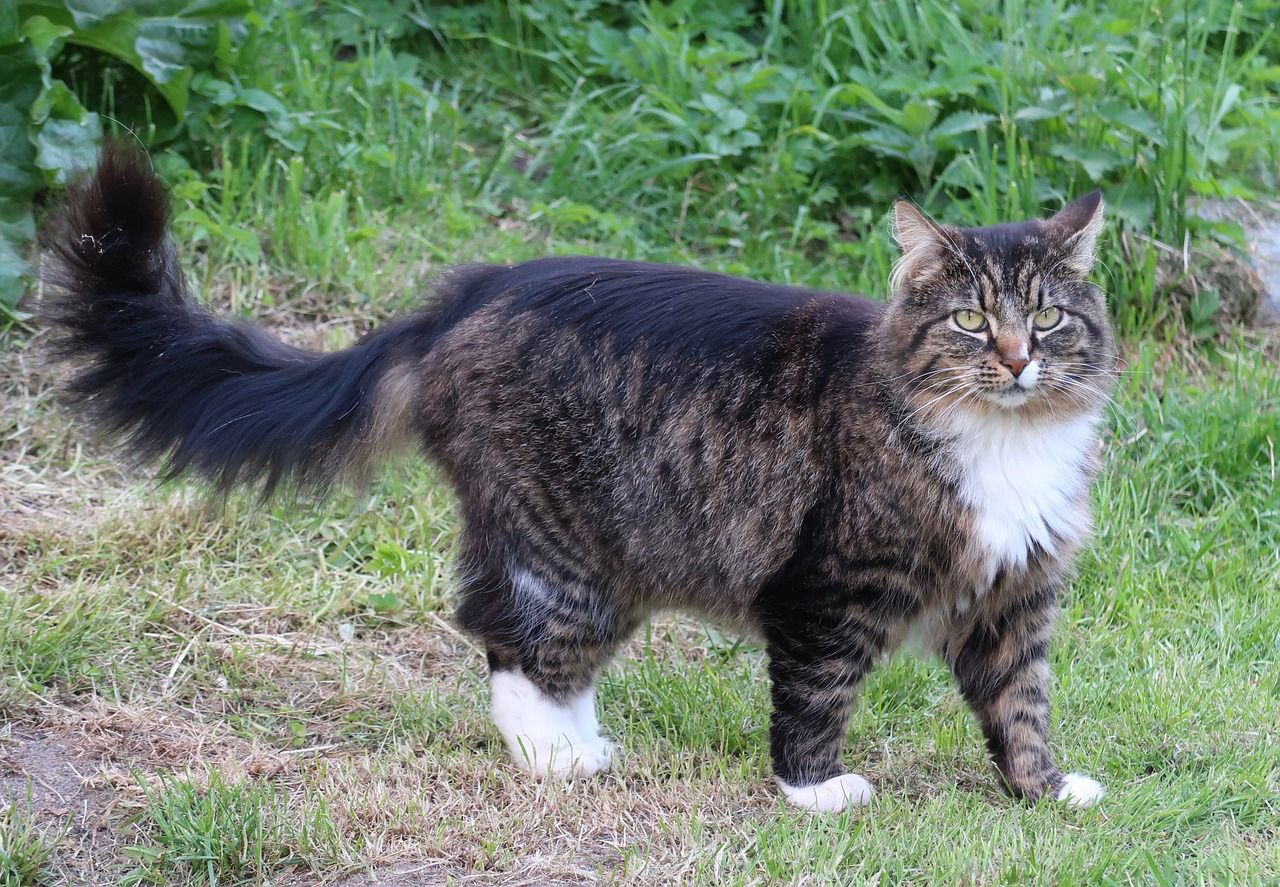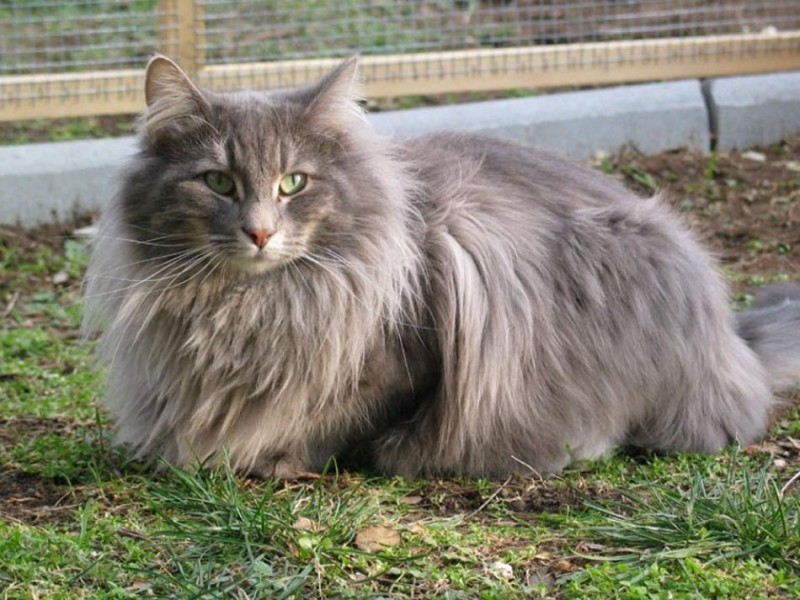Cats with long hair are among the most striking in the world and one of its variants originates from one of the Scandinavian countries. For this reason, in this article you will learn everything about the Norwegian Forest Cat and its care, we invite you to continue reading this article.

How is the Norwegian Forest Cat?
Like cats like the Persian, this Scandinavian specimen also has a semi-long coat. Likewise, they have two levels of fur, an upper one with long hair extensions that help keep the skin from getting too wet, and a much thicker lower one. In the same way as it happens with the Russian variant, the Norwegian Forest cat changes its hair during the climatic seasons: in winter it is very dense, which is essential to be able to withstand the cold winter temperatures of its country of origin. In addition, it has similarities with other breeds of long-haired cats, they even have tufts of hair between their fingers.
It also highlights its very voluminous fur collar. During the summer, the Norwegian Forest Cat loses much of its undercoat, but retains its thick tail and tufts between its toes. A curious fact is that the texture of the coat of the Norwegian Forest cat presents enormous differences in relation to the American cat, although at first glance these two breeds seem similar. The waterproof coating of the Norwegian Forest Coat is sometimes oily and heavy in texture, making it appear a bit patchy and not as silky as the American.
The Norwegian Forest Cat has proven to be very resistant to the very cold and rainy climates of Northern Europe. In addition, it is necessary to mark that they are an integral part of the cats that are classified as large, so that they do not reach their standard size until they are four years old. When the growth period ends, they weigh up to 8 kg. However, Norwegian Forest Cats have longer bodies and legs than other cats that also have slightly long hair. This is why these cats appear so much narrower than, say, the Mancoon.
His face is generally triangular in shape and his ears are set high on his head with hair in and around them. Its hair can be of any color characteristic of domestic cats, even combined with white. Let us highlight, among other things, the striped colors, dyed, more or less intense, with shades of black, blue, red, amber, in various combinations of all these varieties or white. In any case, they are very striking animals. However, you should keep in mind that you can also find specimens with shades of brown.
Character of the Norwegian Forest Cat
These types of cats are known as "giant candies" for good reason: lovers of this breed are captivated by their natural charm. Despite their size, these cats are extremely docile and calm. They can, due to their appearance, give the image of wild cats, but they give themselves totally to their owners. They are distinguished by their very social nature and they also like to share their space with other cats, smaller animals or even dogs. Due to their size and muscular strength, Norwegian Forest Cats are adept enough to climb or jump.
They like to play and hunt and love to be challenged by games like this. A secure garden or terrace with trees or a cat scratcher is ideal for playing, climbing and jumping. Norwegian Forest Cats are extremely curious and also like to be mentally stimulated. The playful instinct and high energy of this cat make it the best playmate for children. They are very tolerant, friendly and are rarely nervous, provided they are properly socialized during the breeding period.
For these reasons, it can be said that it is an excellent feline to live with as a family, since this breed is very sociable. On the other hand, it is recommended that it not be the only domestic cat in the house. So if you have found a good and responsible breeder, the ideal would be to offer a new home for two Norwegian Forest Cats at the same time. If you buy your cat in an animal shelter, you can also ask about its character and recommend the most suitable cats to find the ideal companion.
Care that must be taken
As pristine and robust cats, Norwegian Forest Cats do not require unusual care for a good coexistence in the home. As with all active cats, this type of cat should have access to a secure patio or balcony. An internal scraper ensures that these experienced climbers can remove the skin without damaging furniture or curtains. In addition, it is good to note that they are very sociable and therefore it is not good to leave them alone. They also easily relate to the little ones or even to other animals such as dogs.
However, having another cat brings many advantages, since it needs a companion to play, run, snuggle, among other things. On the other hand, it should be considered that the hair of this breed is very resistant and they can maintain their care mainly on their own. However, if you want to be careful to avoid tangles, it is recommended to brush them once a week. Brushing from a young age is usually adequate. During the shedding period, malt paste and catnip can promote the expulsion of hairballs. An annual veterinary check-up is essential to identify diseases.
Food
Like all cats, they should be given a proper diet rich in fresh meat with healthy protein. Good quality prepared meals more than meet these requirements, but you should always look at the package label and make sure you put meat first. In addition, they should not only consume meat from the muscles, but also from the intestines, such as the heart or liver, which contain important essential nutrients. Vegetable products, sugar and other fillers are also undesirable.
cat health
This cat naturally evolved over time, which explains why it rarely has reproductive problems. For example, premature or stillborn cats are rare. Instead, they are prone to hypertrophic cardiomyopathy. This heart disease is the result of asymmetrical thickening in the left ventricle. Performing a cardiac ultrasound in cats when they are going to have children is the best method to detect hereditary heart diseases at an early stage and prevent the kittens that are born from being affected by them.
Responsible breeders regularly take their cats to the vet and do not hesitate to present the corresponding medical documents. Although there is no cure for hypertrophic cardiomyopathy, the diagnosis offers a number of treatment options to help these cats live a long life. On the other hand, glycogen storage disease (glycogenesis type 4) is also common. It is caused by a recessive gene and is usually found at a late stage. A kitten inherits the gene from one of his parents, so he becomes a carrier and can pass it on to his offspring.
From all this, it can be mentioned that carriers should not participate in breeding. If the cat inherits the gene from both parents, the disease worsens: lack of use and excessive storage of glycogen in liver, muscle and nerve cells can trigger multiple organ failure. Affected cats develop neuromuscular disorders from 5 months of age and have a life expectancy of between 10 and 14 months.
If you liked this article about the Norwegian Forest Cat and want to learn more about other interesting topics, you can check the following links:
